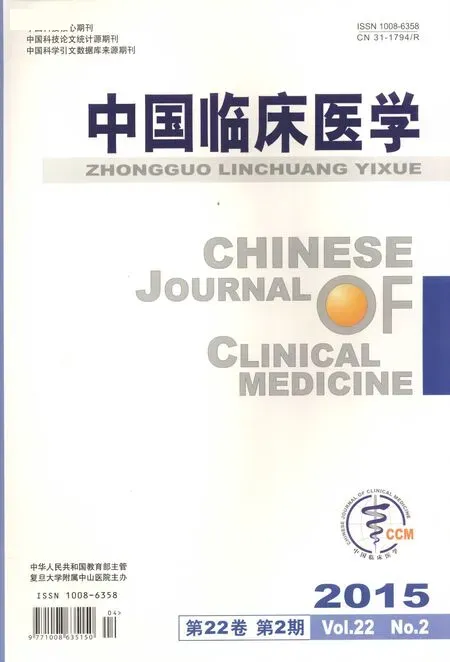AMD3100對索拉非尼治療肝細胞肝癌的療效影響
陸錄 朱文偉 陳進宏 賈戶亮
(復旦大學附屬華山醫院普外科,上海 200040)
?
·論著·
AMD3100對索拉非尼治療肝細胞肝癌的療效影響
陸錄朱文偉陳進宏賈戶亮
(復旦大學附屬華山醫院普外科,上海200040)
摘要目的:觀察基質細胞衍生因子1-α(stromal cell derived factor 1-α, SDF1-α)受體抑制劑AMD3100聯用索拉非尼對肝細胞肝癌(HCC)裸鼠的療效。方法: 建立肝細胞肝癌原位裸鼠模型,分為對照組、索拉非尼組、索拉非尼+AMD3100 組,每組6只。索拉非尼組給予索拉非尼30 mg/(kg·d)灌胃;索拉非尼+AMD3100組在給予索拉非尼灌胃的基礎上,給予AMD3100 2.5 mg/(kg·d)腹腔注射;對照組給予0.9%氯化鈉液灌胃。比較三組的腫瘤肝內播散情況、腫瘤大小、肺轉移情況和裸鼠的生存時間。結果:在索拉非尼治療的基礎上,聯用AMD3100能夠明顯抑制索拉非尼引起的HCC肝內侵襲和轉移,進一步減小腫瘤體積,減少肺轉移,延長荷瘤裸鼠的生存期。結論:SDF1-α受體抑制劑AMD3100能夠增強索拉非尼對HCC的療效。
關鍵詞AMD3100;索拉菲尼;肝細胞肝癌
索拉非尼(sorafenib)是目前晚期肝細胞肝癌(HCC)的一線治療藥物[1]。但是,研究[2-4]發現,索拉非尼在抑制原發瘤的同時促進了轉移瘤的生長。我們的前期研究發現,應用索拉非尼后,腫瘤組織和癌旁微環境中基質細胞衍生因子1-α(stromal cell derived factor 1-α, SDF1-α)的表達明顯增加。因此,本研究將SDF1-α受體抑制劑AMD3100與索拉非尼聯合應用于治療HCC裸鼠模型,探討AMD3100協同索拉非尼治療HCC的療效。
1資料與方法
1.1實驗動物及藥物18只雄性BALB/c裸鼠,6周齡,體質量15~20 g,購自中國科學院上海藥物研究所,在25℃恒溫的SPF級層流室中飼養,12 h光照和12 h黑暗交替,自由進食標準顆粒飼料及飲水。索拉非尼購自拜耳(中國)有限公司, AMD3100購自德國Sigma-Aldrich公司。
1.2裸鼠原位HCC模型的建立無菌條件下將培養的1×107的人HCC LM3細胞注射到裸鼠皮下。待3~4周皮下瘤成瘤后,取瘤原,浸入冷0.9%氯化鈉液中,剪成2 mm×1 mm×1 mm大小備用。以2.5 mg/kg戊巴比妥腹腔注射麻醉裸鼠,消毒手術野,在左肋緣下作長約8 mm的斜切口,將肝葉取出,斜形切開肝表面,植入備好的瘤原組織塊,將肝葉放回原位,用 6-0 線縫合肝切緣,用5-0線雙層縫合腹壁和皮膚。
1.3給藥方法及分組將18只HCC模型裸鼠分為3組,每組6只。模型建立后2周開始給藥。將索拉非尼400 mg溶于100 mL的溶劑(蓖麻油∶乙醇∶dH2O=12.5∶12.5∶75)中,AMD3100溶于0.9%氯化鈉液中。索拉非尼組給予裸鼠索拉非尼30 mg/(kg·d)灌胃;索拉非尼+AMD3100組在給予索拉非尼的基礎上給予裸鼠AMD3100 2.5 mg/(kg·d)腹腔注射。對照組給予0.9%氯化鈉液 0.1mL/d 灌胃。
1.4觀察指標給藥4周后處死裸鼠,取出腫瘤,測量最長徑a和最短徑b,腫瘤體積=ab2/2;取雙肺,石蠟包埋并連續切片,HE染色后讀取每隔5張切片中的肺轉移灶數目。
1.5統計學處理如連續變量呈正態分布,采用t檢驗(Students’t-test);如連續變量呈非正態分布,采用秩和檢驗(Mann-Whitney U test)。P<0.05為差異有統計學意義。
2結果
2.1AMD3100對腫瘤體積及侵襲轉移能力的影響對照組腫瘤平均體積為4.4 cm3。索拉非尼組腫瘤平均體積為2.7 cm3,明顯小于對照組(P=0.02),但腫瘤向肝內播散。與索拉非尼組比較,AMD3100+索拉非尼組腫瘤體積更小,平均為1.3 cm3,差異有統計學意義(P=0.04);腫瘤邊界清晰,肝內播散被明顯抑制。見圖1、2A。

圖1 HCCLM3裸鼠原位瘤模型大體標本
2.2AMD3100對腫瘤肺轉移的影響索拉非尼組裸鼠的肺轉移灶數目較對照組明顯減少(10個比18個,P=0.01),索拉非尼+AMD3100組肺轉移灶的數目進一步減少(4個,P=0.02),見圖2B。

圖2A:裸鼠原位肝細胞肝癌模型腫瘤體積比較;B:裸鼠原位肝細胞肝癌模型肺轉移數目的比較;C:原位肝細胞肝癌模型裸鼠生存時間的比較
2.3AMD3100對裸鼠生存期的影響索拉非尼組的裸鼠平均生存時間為76 d,長于對照組(69 d);索拉非尼+AMD3100組裸鼠的平均生存時間達 91 d。見圖2C。
3討論
抗血管生成在HCC的治療中非常重要[5-6]。索拉非尼是目前臨床上治療晚期HCC的一線用藥,它主要通過抑制血管內皮生長因子(VEGF)發揮抗血管生成的作用[7]。但是兩個大型的臨床研究[8-9]顯示,其對于HCC的治療效果不佳,對患者的中位生存期延長不足3個月。
SDF1又稱為CXCL12,是一種趨化因子,主要由成纖維細胞、炎性細胞、內皮細胞等分泌[10]。SDF1-α通過與其受體CXCR4結合,促進腫瘤的生長[10]。有文獻[11]報道,AMD3100作為CXCR4的特異性抑制劑,能夠增強前列腺癌對于放療的敏感性。AMD3100能夠抑制囊腺癌的嗜神經侵襲[12]。然而,AMD3100應用于肝癌的報道比較少見。本研究將CXCR4的特異性抑制劑AMD3100與索拉非尼聯用,發現AMD3100能夠明顯抑制索拉非尼引起的腫瘤肝內播散,并可進一步減小腫瘤體積、抑制腫瘤肺轉移、延長荷瘤裸鼠的生存時間,說明AMD3100能夠增強索拉非尼的療效。
參考文獻
[1]Llovet JM, Bisceglie AM, Bruix J, et al. Design and endpoints of clinical trials in hepatocellular carcinoma[J]. J Natl Cancer Inst, 2008, 100(10): 698-711.
[2]Ebos JM, Lee CR, Cruz MW, et al. Accelerated metastasis after short-term treatment with a potent inhibitor of tumor angiogenesis[J]. Cancer Cell, 2009, 15(3): 232-239.
[3]Paez-Ribes RM, Allen E, Hudock J, et al. Antiangiogenic therapy elicits malignant progression of tumors to increased local invasion and distant metastasis[J]. Cancer Cell, 2009, 15(3): 220-231.
[4]Zhang W, Sun HC, Wang WQ, et al. Sorafenib down-regulates expression of HTATIP2 to promote invasiveness and metastasis of orthotopic hepatocellular carcinoma tumors in mice[J]. Gastroenterology, 2012, 143(6): 1641-1649.
[5]Farazi PA, DePinho RA, Hepatocellular carcinoma pathogenesis: from genes to environment[J]. Nat Rev Cancer, 2006, 6(9): 674-687.
[6]Pang R, Poon RT, Angiogenesis and antiangiogenic therapy in hepatocellular carcinoma[J]. Cancer Lett, 2006, 242(2): 151-167.
[7]de Lope CR, Tremosini S, Forner A, et al. Management of HCC[J]. J Hepatol, 2012, 56 Suppl: S75-S87.
[8]Llovet JM, Ricci S, Mazzaferro V, et al. Sorafenib in advanced hepatocellular carcinoma[J]. N Engl J Med, 2008, 359(4): 378-390.
[9]Cheng AL, Kang YK, Chen Z, et al. Efficacy and safety of sorafenib in patients in the Asia-Pacific region with advanced hepatocellular carcinoma: a phase III randomised, double-blind, placebo-controlled trial[J]. Lancet Oncol, 2009, 10(1): 25-34.
[10]Sun X, Cheng G, Hao M, et al. CXCL12/CXCR4/CXCR7 chemokine axis and cancer progression[J]. Cancer Metastasis Rev, 2010, 29(4): 709-722.
[11]Domanska UM, Boer JC, Timmer-Bosscha H, et al. CXCR4 inhibition enhances radiosensitivity, while inducing cancer cell mobilization in a prostate cancer mouse model[J]. Clin Exp Metastasis, 2014, 31(7): 829-839.
[12]Jeong WJ, Choi IJ, Park MW, et al. CXCR4 antagonist inhibits perineural invasion of adenoid cystic carcinoma[J]. J Clin Pathol, 2014, 67(11): 992-998.
The Effect of AMD3100 on the Efficacy of Sorafenib in the Treatment of Hepatocellular Carcinoma
LULuZHUWenweiCHENJinhongJIAHuliang
DepartmentofSurgery,HuaShanHospital,FudanUniversity,Shanghai200040,China
AbstractObjective:To investigate the effect of AMD3100, an inhibitor of receptor of stromal cell derived factor 1-α (SDF1-α), combined with sorafenib on nude mice with hepatocellular carcinoma (HCC). Methods:Nude mice models of HCC in situ was established and the mice were divided into control group, sorafenib group and sorafenib combined with AMD3100 group, with six mice in each group. In sorafenib group, sorafenib 30 mg/(kg·d) was given by garage. In sorafenib combined with AMD3100 group, AMD3100 2.5 mg/(kg·d) was administrated by intraperitoneal injection based on the method of sorafenib group. In the control group, 0.9% sodium chloride solution was given by garage. The intrahepatic invasion, the tumor volume, the situation of pulmonary metastasis and the survival time of nude mice, were compared among the three groups. Results: When sorafenib was combined with AMD3100, the intrahepatic invasion and metastasis of HCC caused by sorafenib could be significantly inhibited. Thus the tumor volume was decreased and the pulmonary metastasis could be reduced. The survival time was prolonged. Conclusions: AMD3100, a SDF1-α receptor inhibitor, can enhance the efficacy of sorafenib.
Key WordsAMD3100;Sorafenib;Hepatocellular carcinoma
中圖分類號R735.7
文獻標識碼A
通訊作者賈戶亮,E-mail:jbl-1@163.com
基本項目:國家自然科學基金項目(編號:81101564)

